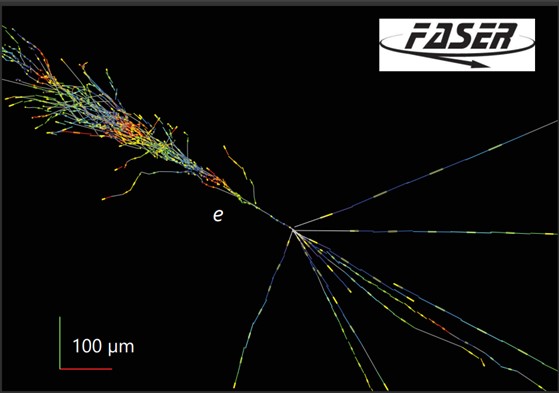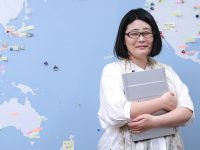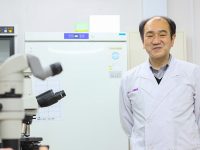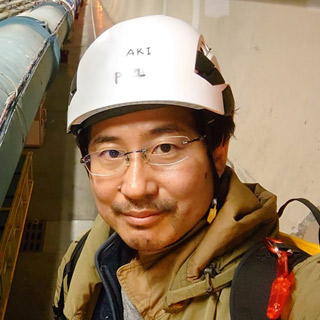Researchers obtain the first direct observation of electron and muon neutrino interactions at the Large Hadron Collider using the FASERν detector
Understanding neutrino interactions is crucial for obtaining a complete picture of particle physics and the universe. To date, neutrino interaction cross sections have not been measured at high energy above some hundred gigaelectronvolts at particle colliders. Now, researchers have obtained the first direct observation of electron and muon neutrino interactions in the Teraelectronvolt range at CERN’s Large Hadron Collider, using the FASERν detector. This study marks a significant step for particle physics research.

Image title: An electron neutrino detected by the FASERν detector at the LHC, the most energetic ever observed from a human source
Image caption: This study marks the first direct observation of electron and muon neutrino interactions at a particle collider, providing crucial insights into particle physics and the fundamental nature of the universe.
Image credit: FASER Collaboration
Image license: CC BY 4.0
Neutrinos are fundamental particles in the Standard Model of particle physics, notable for their extremely small masses and weak interactions with matter. They are important for answering fundamental questions about the universe, including why particles have mass and why there is more matter than antimatter. Despite being abundant, their weak interactions make their detection difficult, and hence they are called “ghost particles.” At any given moment, numerous neutrinos freely pass through the Earth and our bodies, which originate from the Sun or cosmic rays. Understanding their rare interactions with matter is crucial for obtaining a more complete picture of particle physics and the universe.
There are three types, or flavors, of neutrinos: electron neutrinos (νe), muon neutrinos (νμ), and tau neutrinos (ντ). So far, most neutrinos studied by researchers have been low-energy neutrinos. To date, neutrino interaction cross sections, which is the probability of a neutrino interacting with a target particle, had not been measured at energies above 300 gigaelectronvolts (GeV) for electron neutrinos and between 400 GeV and six teraelectronvolts (6000 GeV) for muon neutrinos. In a groundbreaking study, a team of researchers led by Associate Professor Akitaka Ariga from the Graduate School of Science, Chiba University, Japan, also affiliated with the Laboratory for High Energy Physics, University of Bern, Switzerland, and Associate Professor Tomoko Ariga from the Faculty of Arts and Science, Kyushu University, Japan, utilized the Forward Search Experiment (FASER) at CERN’s Large Hadron Collider (LHC), to achieve the first direct observation of high energy electron and muon neutrino interactions at a particle collider. The team included Dr. Ken Ohashi from the Laboratory for High Energy Physics at the University of Bern, Dr. Hiroaki Kawahara from the Faculty of Arts and Science at Kyushu University, and Project-specific Assistant Professor Daiki Hayakawa from the Graduate School of Science, Chiba University, along with other members of the FASER collaboration. Their findings were published in the journal Physical Review Letters on July 11, 2024.
One of the primary objectives of FASER is the study of high-energy neutrinos produced in the LHC’s proton-proton (pp) collisions using the dedicated FASERν detector. Dr. Akitaka Ariga explains, “With FASERν, charged particle tracks produced by neutrino interactions in the detector can be reconstructed with sub-micron precision. This allows us to identify electron and muon charged-current (CC) neutrino interactions and the measurement of neutrino interaction cross-sections in the currently unexplored TeV energy range.”
The FASERν emulsion detector is made of 730 layers of interleaved tungsten plates and emulsion films, with a total target mass of 1.1 tons. The researchers analyzed a subset of the exposed detector volume, corresponding to a mass of 128.6 kg, for high-energy neutrinos from the LHC pp collisions. After applying strict criteria, selecting events with electrons or muons with an energy above 200 GeV, four electron neutrino interaction candidate events and eight muon neutrino interaction candidate events were observed. These interactions had high statistical significance (5.2σ for electron neutrinos and 5.7σ for muon neutrinos), meaning they are highly unlikely to be random background fluctuations and therefore represent actual neutrinos.
The neutrinos detected in the study had energies in the teraelectronvolts range, the highest ever detected from an artificial source. This study marks the first measurement of neutrino interaction cross-sections in the unexplored energy range of 560–1740 GeV for electron neutrinos and 520–1760 GeV for muon neutrinos. Additionally, the measured interaction cross-sections were consistent with Standard Model predictions.
Highlighting the significance of the study, Dr. Akitaka Ariga says, “These results demonstrate the capability of studying flavor-tagged neutrino interactions at TeV energies with the FASERν emulsion-based detector at the LHC. This marks the first ever physics result on neutrinos from a particle collider, a breakthrough in particle physics that could revolutionize the strategy of large-scale experimental research in the field.”
About Associate Professor Akitaka Ariga
Akitaka Ariga is currently an Associate Professor at the Graduate School of Science, Chiba University, Japan. He obtained his MS and Ph.D. degrees from Nagoya University in 2004 and 2008, respectively. He is also the leader of the FASER group at the University of Bern’s Laboratory for High Energy Physics (LHEP). He has about 300 publications with over 13000 citations. He also received the 2023 Chiba University Advanced Academic Award for Pioneering the Frontier of High Energy Neutrino Using Colliders. His research interests include neutrinos, particle physics, nuclear physics, cosmic rays, and astrophysics.
Funding:
This work was supported in part by Heising-Simons Foundation Grant Nos. 2018-1135, 2019-1179, and 2020-1840, Simons Foundation Grant No. 623683, ERC Consolidator Grant No. 101002690, US National Science Foundation Grant Nos. PHY-2111427, PHY-2110929, and PHY-2110648, JSPS KAKENHI Grant Nos. 19H01909, 22H01233, 20K23373, 23H00103, 20H01919, and 21H00082, the joint research program of the Institute of Materials and Systems for Sustainability, BMBF Grant No. 05H20PDRC1, DFG EXC 2121 Quantum Universe Grant No. 390833306, Royal Society Grant No. URF\R1\201519, UK Science and Technology Funding Councils Grant No. ST/ T505870/1, the National Natural Science Foundation of China, Tsinghua University Initiative Scientific Research Program, and the Swiss National Science Foundation.
Reference:
Title of original paper: First Measurement of the νe and νμ Interaction Cross Sections at the LHC with FASER’s Emulsion Detector
Authors: Roshan Mammen Abrahama, John Andersb, Claire Antel c, Akitaka Ariga d,e, Tomoko Ariga ∗∗,f, Jeremy Atkinson d, Florian U. Bernlochner g, Tobias Boeckh g, Jamie Boyd b, Lydia Brenner h, Angela Burger b, Franck Cadouxc, Roberto Cardella c, David W. Casper a, Charlotte Cavanagh i, Xin Chen j, Andrea Coccaro k, Stephane Debieux ´ c, Monica D’Onofrio i, Ansh Desai l, Sergey Dmitrievsky m, Sinead Eley i, Yannick Favrec, Deion Fellers l, Jonathan L. Feng a, Carlo Alberto Fenoglio c, Didier Ferrere c, Max Fieg a, Wissal Filali j, Haruhi Fujimori e, Ali Garabaglu n, Stephen Gibson o, Sergio Gonzalez-Sevilla c, Yuri Gornushkin m, Carl Gwilliam i, Daiki Hayakawa e, Shih-Chieh Hsu n, Zhen Hu j, Giuseppe Iacobucci c, Tomohiro Inada b, Luca Iodice c, Sune Jakobsen b, Hans Joos b,p, Enrique Kajomovitz q, Takumi Kanai e, Hiroaki Kawahara f, Alex Keyken o, Felix Kling r, Daniela Kock ¨ l, Pantelis Kontaxakis c, Umut Kose s, Rafaella Kotitsa b, Susanne Kuehn b, Thanushan Kugathasan c, Helena Lefebvre o, Lorne Levinson t, Ke Li n, Jinfeng Liu j, Margaret S. Lutz b, Jack MacDonald u, Chiara Magliocca c, Fulvio Martinelli c, Lawson McCoy a, Josh McFayden v, Andrea Pizarro Medina c, Matteo Milanesio c, Theo Moretti ´ c, Magdalena Munker c, Mitsuhiro Nakamuraw, Toshiyuki Nakanow, Friedemann Neuhaus u, Laurie Nevay b, Motoya Nonaka e, Kazuaki Okui e, Ken Ohashi d, Hidetoshi Otono f, Hao Pang j, Lorenzo Paolozzi b,c, Brian Petersen b, Markus Prim g, Michaela Queitsch-Maitland x, Hiroki Rokujo w, Elisa Ruiz-Choliz u, Andre Rubbia ´ s, Jorge Sabater-Iglesias c, Osamu Sato w, Paola Scampoli d,y, Kristof Schmieden u, Matthias Schott u, Anna Sfyrla c, Mansoora Shamim b, Savannah Shively a, Yosuke Takubo z, Noshin Tarannum c, Ondrej Theiner c, Eric Torrence l, Svetlana Vasina m, Benedikt Vormwald b, Di Wang j, Yuxiao Wang j, Eli Welch a, Samuel Zahorec b,aa, Stefano Zambito c, Shunliang Zhang j
Affiliations:
- Department of Physics and Astronomy, University of California, USA
- CERN, Switzerland
- D´epartement de Physique Nucl´eaire et Corpusculaire, University of Geneva, Switzerland
- Albert Einstein Center for Fundamental Physics, Laboratory for High Energy Physics, University of Bern, Switzerland
- Department of Physics, Graduate School of Science, Chiba University, Japan
- Kyushu University, Japan
- Universit¨at Bonn, Japan
- Nikhef National Institute for Subatomic Physics, Netherlands
- University of Liverpool, United Kingdom
- Department of Physics, Tsinghua University, United Kingdom
- INFN Sezione di Genova, Italy
- University of Oregon, Japan
- Affiliated with an international laboratory covered by a cooperation agreement with CERN, Switzerland
- Department of Physics, University of Washington, USA
- Royal Holloway, University of London, United Kingdom
- II. Physikalisches Institut, Universit¨at G¨ottingen, Germany
- Department of Physics and Astronomy, Technion—Israel Institute of Technology, Israel
- Deutsches Elektronen-Synchrotron DESY, Germany
- ETH Zurich, Switzerland
- Department of Particle Physics and Astrophysics, Weizmann Institute of Science, Israel
- Institut f¨ur Physik, Universit¨at Mainz, Germany
- Department of Physics & Astronomy, University of Sussex, United Kingdom
- Nagoya University, Japan
- University of Manchester, School of Physics and Astronomy, Japan
- Dipartimento di Fisica “Ettore Pancini”, Universit`a di Napoli Federico II, Italy
- Institute of Particle and Nuclear Studies, KEK, Japan
- Charles University, Faculty of Mathematics and Physics, Czech Republic
**Corresponding author. Email: ariga@artsci.kyushu-u.ac.jp
Journal: Physical Review Letters
DOI: 10.1103/PhysRevLett.133.021802
Contact:
Akitaka Ariga
Graduate School of Science, Chiba University and Albert Einstein Center for Fundamental Physics, University of Bern
Email: ariga@chiba-u.jp
Tomoko Ariga
Faculty of Arts and Science, Kyushu University
Email: ariga@artsci.kyushu-u.ac.jp
Public Relations Office, Chiba University
Address: 1-33 Yayoi, Inage, Chiba 263-8522 JAPAN
Email: koho-press@chiba-u.jp
Tel: +81-43-290-2018
Public Relations Division, Kyushu University
Address: 744 Motooka Nishi-ku Fukuoka 819-0395
Email: sysintlkh@jimu.kyushu-u.ac.jp
Tel: +81-92-802-2443
Recommend
-

Navigating the Society-driven Research: PPI and the Quest for Research Integrity
2025.02.27
-

The World of Mold around Us: The A to Z of Mold
2023.04.06
-

Unfettered thinking, elaborate theorizing, and an accepting and positive attitude: With the precepts of his former supervisors in mind, Dr. Shimada is tackling the global food crisis
2023.01.04


